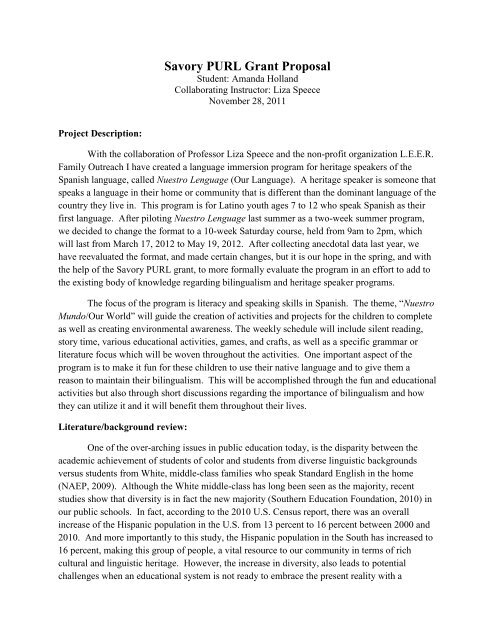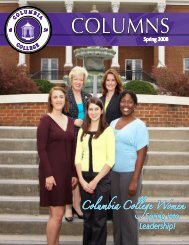Savory PURL Grant Proposal - Columbia College
Savory PURL Grant Proposal - Columbia College
Savory PURL Grant Proposal - Columbia College
You also want an ePaper? Increase the reach of your titles
YUMPU automatically turns print PDFs into web optimized ePapers that Google loves.
Project Description:<br />
<strong>Savory</strong> <strong>PURL</strong> <strong>Grant</strong> <strong>Proposal</strong><br />
Student: Amanda Holland<br />
Collaborating Instructor: Liza Speece<br />
November 28, 2011<br />
With the collaboration of Professor Liza Speece and the non-profit organization L.E.E.R.<br />
Family Outreach I have created a language immersion program for heritage speakers of the<br />
Spanish language, called Nuestro Lenguage (Our Language). A heritage speaker is someone that<br />
speaks a language in their home or community that is different than the dominant language of the<br />
country they live in. This program is for Latino youth ages 7 to 12 who speak Spanish as their<br />
first language. After piloting Nuestro Lenguage last summer as a two-week summer program,<br />
we decided to change the format to a 10-week Saturday course, held from 9am to 2pm, which<br />
will last from March 17, 2012 to May 19, 2012. After collecting anecdotal data last year, we<br />
have reevaluated the format, and made certain changes, but it is our hope in the spring, and with<br />
the help of the <strong>Savory</strong> <strong>PURL</strong> grant, to more formally evaluate the program in an effort to add to<br />
the existing body of knowledge regarding bilingualism and heritage speaker programs.<br />
The focus of the program is literacy and speaking skills in Spanish. The theme, “Nuestro<br />
Mundo/Our World” will guide the creation of activities and projects for the children to complete<br />
as well as creating environmental awareness. The weekly schedule will include silent reading,<br />
story time, various educational activities, games, and crafts, as well as a specific grammar or<br />
literature focus which will be woven throughout the activities. One important aspect of the<br />
program is to make it fun for these children to use their native language and to give them a<br />
reason to maintain their bilingualism. This will be accomplished through the fun and educational<br />
activities but also through short discussions regarding the importance of bilingualism and how<br />
they can utilize it and it will benefit them throughout their lives.<br />
Literature/background review:<br />
One of the over-arching issues in public education today, is the disparity between the<br />
academic achievement of students of color and students from diverse linguistic backgrounds<br />
versus students from White, middle-class families who speak Standard English in the home<br />
(NAEP, 2009). Although the White middle-class has long been seen as the majority, recent<br />
studies show that diversity is in fact the new majority (Southern Education Foundation, 2010) in<br />
our public schools. In fact, according to the 2010 U.S. Census report, there was an overall<br />
increase of the Hispanic population in the U.S. from 13 percent to 16 percent between 2000 and<br />
2010. And more importantly to this study, the Hispanic population in the South has increased to<br />
16 percent, making this group of people, a vital resource to our community in terms of rich<br />
cultural and linguistic heritage. However, the increase in diversity, also leads to potential<br />
challenges when an educational system is not ready to embrace the present reality with a
willingness to adapt and change to meet the varying needs of students from unique backgrounds.<br />
As previously mentioned, a heritage speaker is a child who was born outside of their<br />
parent‟s country of origin or moved from the country of origin before the age of 8 (Benmamoun,<br />
Montrul, and Polinsky). Most often the term refers to children of immigrants who speak a<br />
different language such as Spanish as their first language. Typically, the children are learning<br />
English in school, not Spanish. This results in children who can speak both languages but often<br />
have weak or poor literacy skills in both, because these children are too often asked to leave their<br />
home languages at the schoolhouse door without consideration for the importance of home<br />
languages, the value that multiple languages could have in classrooms, and the impact of using<br />
home languages on students‟ academic achievement (Nieto, 2010; Cummins, 2000; Valdés,<br />
1996; Gonzalez, 2001).<br />
Because the public school systems have failed thus far to recognize the importance of<br />
these children‟s linguistic abilities, I decided to create Nuestro Lenguaje in hopes of not only<br />
bettering their academic performance but also encouraging the continuance of their bilingualism.<br />
Studies demonstrate that being bilingual has many benefits. The University of Granada recently<br />
published findings stating, “bilingualism not only improves attention span, but it also trains the<br />
person‟s memory, like a sort of „mental gymnastics‟” (Valerio, 2011). With the knowledge of<br />
two languages children are more prone to an active and healthy mind, leading them to further<br />
excel in their academics. Beyond the classroom, bilingualism sustains its importance through the<br />
rising need for bilingual workers. These jobs usually come with a higher salary therefore leading<br />
those who are bilingual to better jobs and higher wages (Weathers, 2011). Throughout this<br />
program I will focus on how bilingualism is important and how having that ability is something<br />
to be proud of. I want to help them maintain their native language and culture so that it not only<br />
stays with them for the rest of their lives, but so it can also enrich our communities and schools.<br />
Research Questions and Methodology<br />
In order to add to the existing body of knowledge regarding bilingualism and heritage<br />
speaker programs for elementary aged children, we will be using the following question to guide<br />
our research:<br />
� How does a 10-week immersion program for elementary aged heritage speakers of<br />
Spanish improve their desire/motivation to use Spanish in daily life?<br />
a. Furthermore, how will such a program improve their reading and writing skills in<br />
Spanish?<br />
b. Will such a program affect their desire to continue and improve their<br />
bilingualism?<br />
We will answer these questions by collecting data using the following methods:<br />
� Entrance and exit survey<br />
� Pre and post test on reading/writing skills in Spanish
� Descriptive data/notes<br />
� Student reflections<br />
� Staff/volunteer reflections<br />
Expected outcomes:<br />
We believe the students‟ desire to use Spanish will improve, as well as their reading and<br />
writing skills in Spanish. In such a short course, we expect that the largest increase will be in<br />
motivation, although spelling and grammar will also improve as well as written fluency.<br />
Students’ Roles and Responsibilities:<br />
As the director of Nuestro Lenguaje, I will be overseeing everything regarding the<br />
program and regarding the work of the assistant director, Lea Stapleton. I will also be in charge<br />
of gathering the data for this research project. This includes collaborating with Professor Speece<br />
and Lea in creating a pre and post test and an entrance and exit survey for the participants of the<br />
program to complete. Both Lea and I will be responsible for writing short (1-2 paragraphs)<br />
reflections for each day of the program in order to have data from the view point of the program<br />
instructors. In regards to the actual program, I will be responsible for creating promotional<br />
material and Lea and I will distribute it within the schools and communities that have children<br />
who would most benefit from this type of program (with the permission of school<br />
administration). Not only will we be planning each day‟s lessons and activities, but we will also<br />
be the lead instructors for each day, with possible help and assistance from volunteers.<br />
Faculty Mentor’s Role and Responsibilities:<br />
Ms. Speece will meet with me on a bi-weekly basis to discuss and monitor progress<br />
toward the completion of goals, and will be providing access to the non-profit organization<br />
L.E.E.R. Family Outreach. She will act as a proofreader for all correspondence regarding the<br />
program and will help design, develop, and administer all pre and post tests and entrance and exit<br />
surveys, as well as advise on other methods of data collection. Once the data has been collected<br />
Ms. Speece will help interpret the findings.
Itemized Budget:<br />
Materials: $215.00<br />
Set of supplies for 20 students<br />
(crayons/scissors/glue/journals)<br />
Craft Project Materials<br />
Copies<br />
(activities/worksheets/forms)<br />
Food: $200.00<br />
Snacks or Lunch for 10 days<br />
(Program is from 9am-2pm)<br />
Books:<br />
Bilingual books/Sets of English/Spanish books $150.00<br />
(will support the curriculum and the multiple<br />
silent reading times)<br />
Advertising: $100.00<br />
Flyers/posters<br />
Gifts for completion: $150.00<br />
T-shirts<br />
Recycle bags (Environmental theme)<br />
Transportation: $160.00<br />
Gas ($0.33 per mile)<br />
@24 miles a day (10 days) for 2 people<br />
Digital Camera: $175.00<br />
FUJIFILM - FinePix S2950<br />
(Capturing photos for presentation)<br />
Total: $1150.00
Works Cited<br />
Benmamoun, Elabbas, Silvina Montrul, and Maria Polinksy. "White Paper: Prolegomena to<br />
Heritage Linguistics." Heritage Languages. National Heritage Language Learning<br />
Center, n.d. Web. 1 May 2011. .\<br />
Cummins, Jim. (2000). Language, power and pedagogy. Tonawanda, NY: Cambrian<br />
Printers Ltd.<br />
Gonzalez, N. (2001). I am my language. Tucson: The University of Arizona Press.<br />
National Assessment of Education Progress (NAEP) (2009).<br />
<br />
Nieto, S. (2010). Language, culture, and teaching : critical perspectives for a new century (2nd<br />
ed.). New York: Routledge.<br />
Southern Education Foundation. (2010). A new diverse majority. www.southerneducation.org<br />
Valdes, G. (1996). Con respeto. New York: Teachers <strong>College</strong> Press.<br />
Valerio, Maria. "Las ventajas de ser bilingüe." NEUROLOGÍA: Reunión científica en<br />
Washington. N.p., 18 Feb 2011. Web. 1 May 2011.<br />
.<br />
Weathers, 2011. “Forbes Insights Study Outlines the Importance of Multilingualism in Business”<br />
Business Wire,




